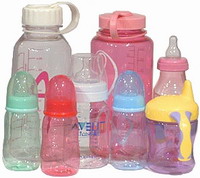FDA approves use of products made of bisphenol A
The U.S. Food and Drug Administration has recently approved the use of products made of organic compound bisphenol A (abbreviated BPA).

Bisphenol A’s current uses are numerous. It is used in the synthesis of polyesters, polysulfones, and polyether ketones, as an antioxidant in some plasticizers, and as a polymerization inhibitor in PVC. It is a key monomer in production of polycarbonate plastic and epoxy resins. Polycarbonate plastic, which is clear and nearly shatter-proof, is used to make a variety of common products including baby and water bottles, sports equipment, medical devices, CDs, and household electronics.
The chemical is actually quite controversial because it mimics estrogen and thus could induce hormonal responses. In spite of this, the FDA and the chemical industry unanimously defend the safety of BPA.
The first evidence of the estrogenicity of BPA came from experiments in the 1930s in which it was fed to rats. Since then, its endocrine disrupting properties have been extensively investigated, and more than 100 studies have been published "raising health concerns" about the chemical. For example, studies have demonstrated developmental toxicity, carcinogenic effects, and possible neurotoxicity at low doses in animal models. Recent studies suggest it may also be linked to obesity by triggering fat-cell activity and have confirmed that bisphenol A exposure during development has carcinogenic effects and produce precursors of breast cancer. However, neither the U.S. Environmental Protection Agency nor the International Agency for Research on Cancer have evaluated Bisphenol A for possible carcinogenic activity.
In 2007, a consensus statement by 38 experts on bisphenol A concluded that average levels in people are above those that cause harm to animals in laboratory experiments, and a panel convened by the U.S. National Institutes of Health determined that there was "some concern" about BPA's effects on fetal and infant brain development and behavior.
A 2008 draft report by the U.S. National Toxicology Program (NTP) agreed with the panel, concluding that "there is some concern for neural and behavioral effects in fetuses, infants, and children at current human exposures," and that there is "some concern for bisphenol A exposure in these populations based on effects in the prostate gland, mammary gland, and an earlier age for puberty in females." The NPT also concluded that there is negligible concern that "exposure of pregnant women to bisphenol A will result in fetal or neonatal mortality, birth defects or reduced birth weight and growth in their offspring" or that it causes adverse effects in exposed adults.
In April 2008, the Canadian government released its Draft Screening Assessment for bisphenol A, which concluded that the chemical may pose some risk to infants and proposed classifying the chemical as "'toxic' to human health and the environment." This action follows Canadian regulators selection of bisphenol A in 2006 as one of 200 substances deserving of thorough safety assessments after preliminary studies had found it to be "inherently toxic"; the chemical had not previously been studied by them in depth, having been accepted under grandfather clauses when stricter regulations were passed in the 1980s.
In contrast to the recent actions in North America, in January 2006 the German Federal Institute for Risk Assessment announced that polycarbonate baby bottles are safe and stated that published research on the health effects of Bisphenol A is "difficult to interpret and is occasionally contradictory". An assessment released later that year by the European Union’s Food Safety Authority reached a similar conclusion, expressing "considerable reservations" about the biological significance and robustness of the low-dose exposure studies on rodents. In 2007 Japan also concluded that "the current exposure levels of BPA will not pose any unacceptable risk to human health that a ban is not needed."
Some toxicologists and regulatory agencies have criticized low-dose toxicity studies, especially those that involved injecting bisphenol A directly into animals, since human exposures typically involve ingestion and subsequent metabolization in the liver, and the experimental design of some of these studies has also been questioned. Studies have also appeared pointing out flaws in chemical industry funded studies that found no evidence of adverse effects from low dose exposure, and a study from 2008 concluded that blood levels of bisphenol A in neonatal mice are the same whether it is injected or ingested.
Photo: www.shahine.com
Subscribe to Pravda.Ru Telegram channel, Facebook, RSS!


